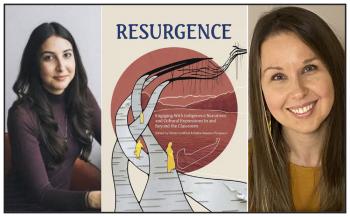Image Caption
Summary
Local Journalism Initiative Reporter
Windspeaker.com
Over the past several years, calls have come from across Canada for the inclusion of Indigenous worldviews and knowledge in all levels of education in the country.
Enter the teachers’ guide Resurgence: Engaging With Indigenous Narratives and Cultural Expressions In and Beyond the Classroom.
Featuring works from such authors as David A. Robertson, Sara Florence Davidson, Lisa Boivin, Louise B. Halfe and Nicola I. Campbell, Resurgence will be available for purchase on April 26 via Portage & Main Press.
The collection was edited by Christine M'Lot and Katya Adamov Ferguson, a pair of educators based in Winnipeg. It’s for teachers of Kindergarten through to Grade 12.
M’Lot works as a university-preparatory high school teacher at the Collegiate at the University of Winnipeg, while Adamov Ferguson is a PhD student engaging in curriculum redesign and place-based inquiries.
“I think it's important for teachers to include a diverse perspective in their curriculum, and just recognise that these things are an ongoing conversation,” M'Lot said in an interview with Windspeaker.com.
M’Lot said teachings from her Anishinaabe background work in tandem with Adamov Ferguson’s commitment to advancing teacher professional learning in the area of Indigenous education.
“As educators, we have the responsibility to integrate these things into our classrooms: Indigenous content and perspectives and processes,” M'Lot said. “The fact that we're working together just hopefully inspires our readers to benefit from both of our insights as an Indigenous and non-Indigenous educator.”
Resurgence contains “practical action steps” designed to “support readers in discovering Indigenous narratives and using Indigenous works in teaching.”
“It's kind of crossing boundaries of, you know, old and new,” Adamov Ferguson said. “I think some of these pieces are really reflective of that. There's some samples where the contributors are talking about their past and the present and their future hopes or using contemporary technology there. It is kind of looking at time in a more significant way.”
The book is part of the Footbridge Series. “[The footbridge on the cover] really represents the journey that we're all on,” M’Lot said. “And it represents how we can bring new things into the classroom with our book that really focuses on having the teacher as a learner as well. And so we’re really guiding educators and teachers in these processes, as well as the students.”
The book is for teachers, educators, librarians and parents, or “anyone interested in understanding how to further engage with Indigenous perspectives for greater equity in their classroom, community or family.”
“We were engaging with these works and trying to find ways to make these texts or to support teachers in bringing these texts into their classrooms and how to support teachers in their own professional learning,” Adamov Ferguson added.
A press release for the book suggests that its readers should use Resurgence as “a springboard for your own learning journey or as a lively prompt for dialogue within your professional learning community.”
Both editors said the process of aggregating the collection was also a learning process on their part.
“We're lifelong learners committed to learning and unlearning and relearning what it means to honour these Indigenous perspectives and ways of knowing,” M’Lot said.
The book looks to highlight critical engagement with each author’s work.
“The things that are often talked about, such as residential schools, the child welfare system, these are systems of oppression that you know are continuing today and sort of have a different face today,” M'Lot said. “[But] I think it's important to talk about trauma and resilience equally as much.”
M’Lot emphasised that the book is intended to continue the process of reconciliation.
“We definitely wanted to talk about these topics in a positive way,” M’Lot added. “We have so many smart and talented Indigenous creatives that are making waves in their communities and professions. And this book really highlights many of those people. And so, it is very much a resurgence of culture and ways of knowing and learning.”
Local Journalism Initiative Reporters are supported by a financial contribution made by the Government of Canada.

